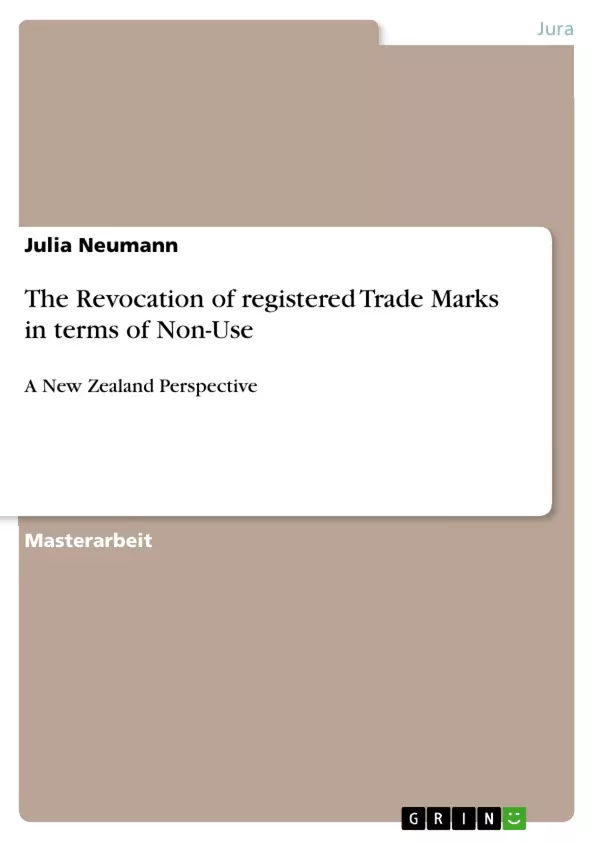This paper deals with the non-use of registered trade marks. It mainly focuses on the trade mark system of New Zealand; however it compares this with selected issues of foreign trade mark systems. Unexpectedly, the non-use of registered trade marks is a topic which closely relates to the vivid field of promotion, competition, and globalization, although it is embedded in the rather static system of registration and administration. The non-use of a registered trade mark enables the opposition to initiate a procedure of revocation from the trade mark register against the respective trade mark. With removal from the trade mark register the trade mark rights of the owner hereby granted cease. Therefore, the application of revocation from the trade mark register in terms of non-use is, beside other grounds for removal, a common tactic of competitors to shed blocking trade marks.
This paper shall give an overview of the formal procedure of application, including the legal aspects of the requisite standing, the competent forum and the burden of proof. However, the main focus of this analysis encompasses the legal term and definition of the use (“genuine use”) of a trade mark. Unfortunately, New Zealand legislation as well as other Common Law and Civil Law jurisdictions gives minimal guidance on the interpretation of the term “genuine use”. Although, European jurisdiction created and confirmed a common understanding by pointing out some main criteria, this definition only constitutes a framework. Subsequently, the term has been formed through case-by-case decisions of national and overseas courts and the Intellectual Property Office. Therefore, this paper will provide different case examples of the jurisdiction of New Zealand and other jurisdictions. However, the line of cases will show the variety regarding the determination of “genuine use”. A comprehensive and universal definition of the term cannot be established. Actions made in respect of a trade mark can only be evaluated as “genuine use” in regard to the specific circumstances.
Inhaltsverzeichnis
- Kapitel 1: Introduction to the system of trade marks.
- A. Functions of trade marks
- Kapitel 2: Removal from the trade mark register
- A. Grounds for removal from the register
- I. Cancellation
- II. Revocation
- 1. Non-Use, s 66 (1) (a), (b) TMA 2002.
- 2. Genericism, s 66 (1) (c) TMA 2002.
- 3. Deception, s 66 (1) (d) TMA 2002.
- 4. Confusion, s 66 (1) (e) TMA 2002.
- B. Reasons for removal
- C. Formal procedure
- I. Standing.
- II. Forum
- III. Application of revocation in terms of non-use
- IV. Burden of proof on grounds of non-use
- V. Extent and consequences of revocation
- VI. Re-application
- A. Grounds for removal from the register
- Kapitel 3: Non-Use
- A. Legal term non-use
- B. Key considerations on genuine use
- I. Case examples of sufficient use
- 1. Minimum-level and end-user sales
- 2. Promotional materials and price lists
- 3. Test-marketing..
- 4. Internet sales.
- 5. Licensing.
- II. Cases of insufficient use
- I. Case examples of sufficient use
- C. "Special circumstances".
Zielsetzung und Themenschwerpunkte
Diese Arbeit befasst sich mit der Nichtbenutzung eingetragener Marken. Der Schwerpunkt liegt auf dem Markensystem Neuseelands, wobei Vergleiche mit ausgewählten Fragen ausländischer Markensysteme gezogen werden. Überraschenderweise hängt die Nichtbenutzung eingetragener Marken eng mit dem lebendigen Bereich der Werbung, des Wettbewerbs und der Globalisierung zusammen, obwohl sie in das eher statische System der Registrierung und Verwaltung eingebettet ist. Die Nichtbenutzung einer eingetragenen Marke ermöglicht es dem Gegner, ein Verfahren zur Löschung aus dem Markenregister gegen die jeweilige Marke einzuleiten. Mit der Löschung aus dem Markenregister erlöschen die dem Inhaber hierdurch verliehenen Markenrechte. Daher ist die Anwendung der Löschung aus dem Markenregister im Sinne der Nichtbenutzung neben anderen Gründen für die Löschung eine gängige Taktik von Wettbewerbern, um blockierende Marken loszuwerden.
- Das Verfahren zur Löschung einer Marke aufgrund von Nichtbenutzung
- Die rechtliche Definition und Interpretation des Begriffs "echte Benutzung" einer Marke
- Die Rolle von Fallbeispielen in der Auslegung des Begriffs "echte Benutzung"
- Der Einfluss von "besonderen Umständen" auf die Beurteilung der Markenbenutzung
- Der Vergleich des neuseeländischen Markensystems mit anderen Rechtsordnungen
Zusammenfassung der Kapitel
Kapitel 1 bietet eine Einführung in das System der Marken und erläutert deren Funktionen. Kapitel 2 behandelt die Löschung aus dem Markenregister, einschließlich der Gründe für die Löschung und des formalen Verfahrens. Kapitel 3 konzentriert sich auf die Nichtbenutzung von Marken, analysiert den rechtlichen Begriff der Nichtbenutzung und untersucht verschiedene Fallbeispiele, um die Bedeutung von "echter Benutzung" zu verdeutlichen.
Schlüsselwörter
Markenrecht, Nichtbenutzung, Löschung, echtes Benutzung, Markenregister, Wettbewerbsrecht, Globalisierung, Fallbeispiele, Neuseeland, internationales Markenrecht.
- Citar trabajo
- Julia Neumann (Autor), 2010, The Revocation of registered Trade Marks in terms of Non-Use , Múnich, GRIN Verlag, https://www.grin.com/document/166830



